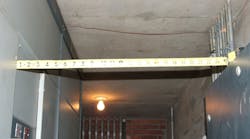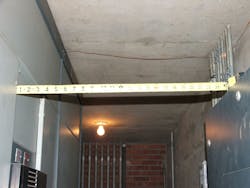Hint: short-sighted layout
See the answer below
This electric room simply seems too small. Where is the required working space? Table 110.26(A)(1) requires a minimum working space depth of at least 3 ft for all conditions and voltages. Some conditions require more than 3 ft of depth, but this depth is never supposed to be less than 3 ft. A close look at my tape measure in the photo reveals the epic failure of this electric room layout. There is only 2 ft of space between the switchboard on the left and the panelboard on the right. Imagine what might happen if you crammed yourself into such a tight workspace and there was an accidental arc-flash explosion while troubleshooting or taking some voltage readings. It would be a really bad situation for you, that’s for sure.
Section 110.26(A)(1)(c) allows Condition 2 working space depths instead of Condition 3 depths to be used in existing buildings where equipment is being replaced, but it never allows less than 3 ft of depth. I’m not sure what happened with the design of this room and installation of the equipment, but somewhere along the way, somebody seems to have overlooked something or misread a print or drawing.





